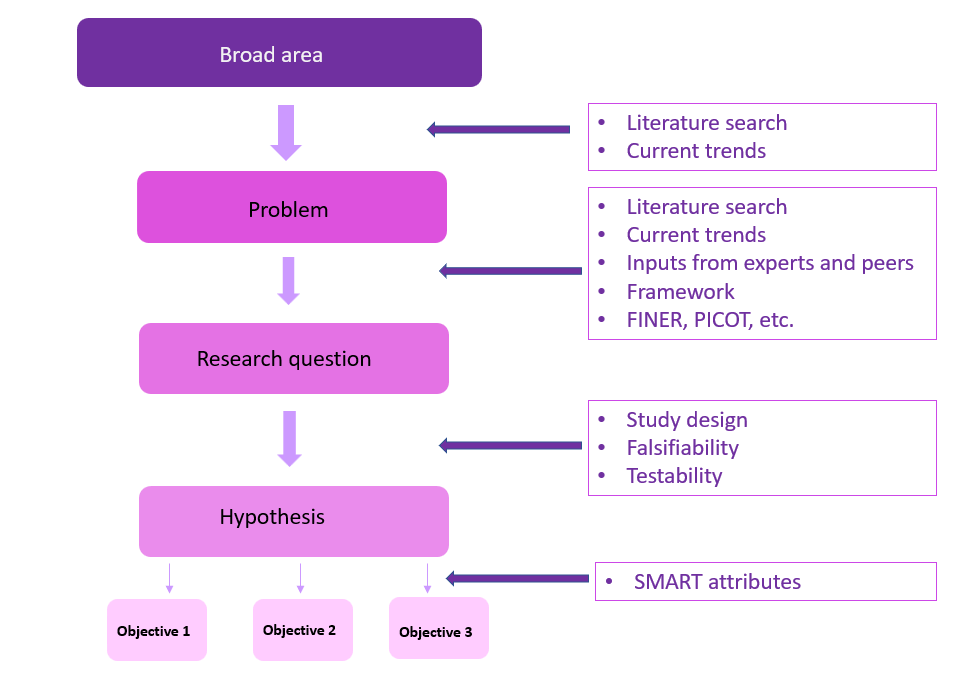Developing and framing Research Objectives
Well-developed and focused research objectives go a long way in ensuring the success of a research project. The objectives even steer and shape the way the resulting research paper is structured. This article explains how to develop and frame your research objectives. Before that, let’s clarify the difference between research aims and objectives.
Research objective vs. research aim
- Focus: A research aim describes the central goal or purpose of the study, broadly indicating what is to be achieved. Objectives specify how it will be achieved. Thus, research objectives divide the main aim into parts and address each part separately. While drafting a dissertation or thesis, the objectives can be used as a reference to establish the structure for the paper’s sections and subsections (or chapters).
- Form: A research aim is expressed as a single sentence or short paragraph, while research objectives are listed out in numbered form (bulleted or in running text).
Developing research objectives: Process
Let’s look at how you should move from the problem statement to the objectives. (See figure below.)
First, you come up with a problem statement describing the problem that needs solving (a controversy, knowledge gap, aspect that can be improved/enhanced, etc.), along with the rationale, which justifies the study.
You then formulate the central question of the study that is to be answered based on the study findings.
The research hypothesis is the formal prediction that is to be tested.
So, where do the objectives fit in?
The research objectives specify how the research question will be answered; in other words, the objectives determine what is to be measured to test the hypothesis.

Progression from a problem statement in a broad area of study to the development of the research objectives
Developing research objectives: Pointers
- Objectives guide the choice or development of the necessary methodology for the study.
- The objectives and research questions should be aligned with the overall problem being researched. They are intricately related: the objectives cannot be met without answering the research questions!
Framing research objectives
- Objectives should be ‘SMART’:
- Specific
- Measurable
- Attainable
- Relevant
- Time-based
- Objectives should be stated using action verbs, for example…
- To investigate…
- To explore…
- To ascertain the impact of…
- To compare…
- Objectives should be stated in logical sequence.
Research objective: Example(s)
Here is an example containing multiple research objectives, beginning with a problem statement.
- Problem statement
Biodiversity losses are accelerating in the forests of northeast India. While measures are being taken by diverse players to stem these losses, there has been no formal study to quantify or compare the effects of the steps taken.
- Research question
How do interventions by government research institutes compare with actions by indigenous people in managing plant biodiversity loss in the forests of Meghalaya, India?
- Research hypothesis
Actions and interventions by indigenous people and local communities are more effective than interventions by government research institutes in plant genetic resource conservation in the forests of Meghalaya.
- Research objectives
To investigate and compare the impact of the effectiveness of plant genetic resource conservation measures by research institutes and those by indigenous people and local communities in the forests of Meghalaya.
To examine the ecological outcomes of specific conservation practices followed by local communities in Meghalaya.
To identify specific plant species rescued by local communities in Meghalaya in the last few years.
Maximise your publication success with Charlesworth Author Services.
Charlesworth Author Services, a trusted brand supporting the world’s leading academic publishers, institutions and authors since 1928.
To know more about our services, visit: Our Services